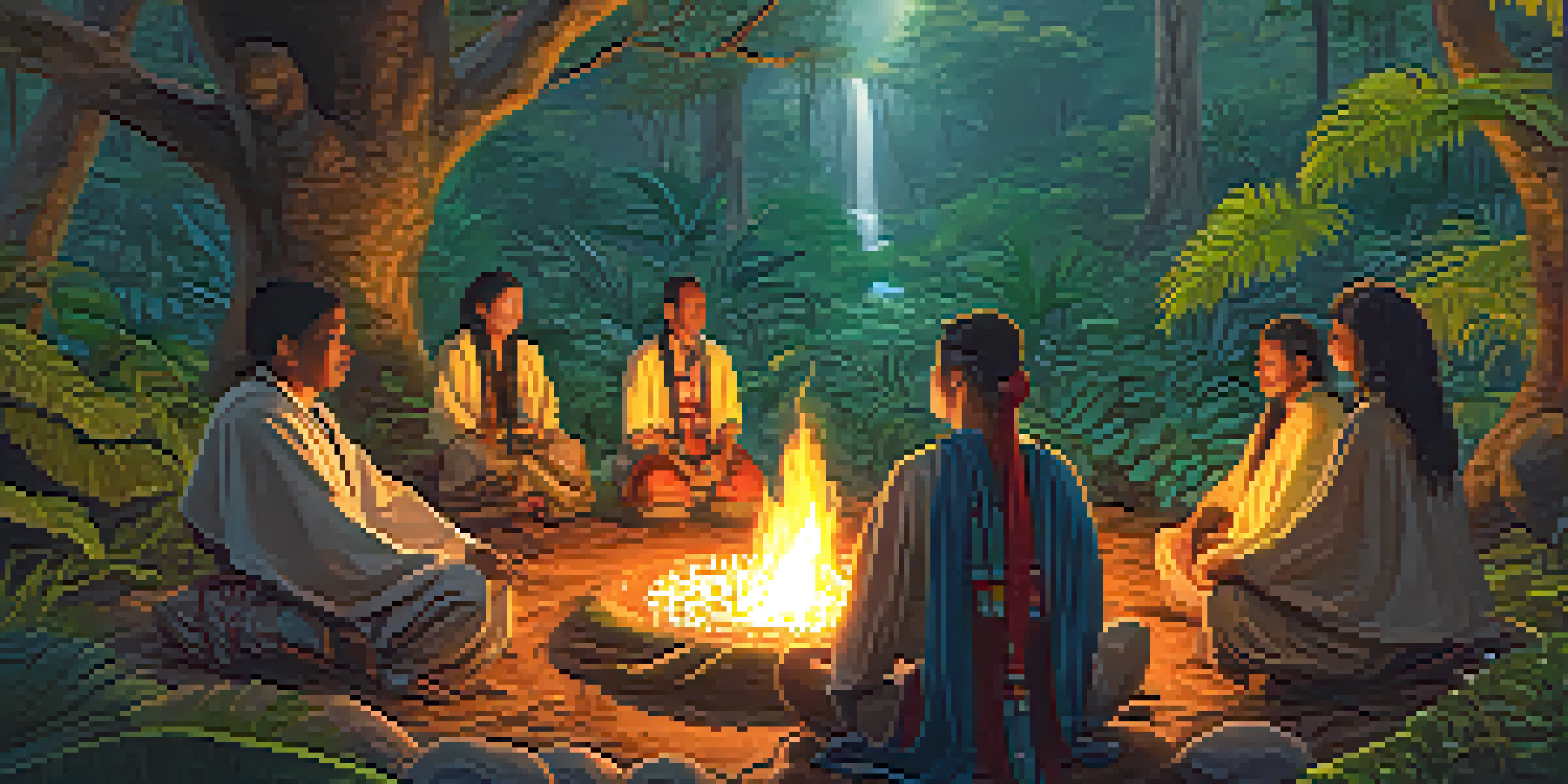Ayahuasca Retreats: Healing Journeys and Medical Considerations

What is Ayahuasca and Its Cultural Significance?
Ayahuasca is a traditional brew made from the Banisteriopsis caapi vine and the Psychotria viridis leaf, primarily used in indigenous Amazonian cultures. This psychoactive drink has been employed for centuries in spiritual and healing ceremonies, often guided by experienced shamans. The cultural significance of Ayahuasca lies in its role as a tool for connecting with the spiritual world and fostering community among participants.
The experience of Ayahuasca can be a catalyst for profound personal transformation.
These retreats often take place in lush natural settings, where participants can immerse themselves in the environment while undergoing a transformative experience. The rituals surrounding Ayahuasca consumption emphasize respect, intention, and connection, highlighting the importance of the community in the healing process. This blend of nature, culture, and spirituality creates a unique atmosphere that many find deeply healing.
As interest in Ayahuasca grows outside of its traditional context, it’s essential to understand its roots and significance. The experience is not just about the psychoactive effects; it’s also about the shared journey and the lessons learned from the ceremony. Understanding this cultural backdrop can enhance one’s experience and provide a more respectful approach to participating in a retreat.
The Healing Potential of Ayahuasca Experiences
Many people seek out Ayahuasca retreats for their reported healing benefits, particularly for mental health issues such as depression, anxiety, and PTSD. Participants often describe profound emotional releases and insights that can lead to significant transformations in their lives. The experience can help individuals confront past traumas, gain clarity, and develop a deeper understanding of themselves.

Scientific studies on Ayahuasca suggest it may have therapeutic potential, particularly due to its active compound, DMT (dimethyltryptamine). This compound interacts with serotonin receptors in the brain, potentially leading to altered states of consciousness that facilitate healing. While the research is still in its infancy, early findings are promising and point toward the possibility of Ayahuasca as a complementary treatment for certain psychological conditions.
Cultural Roots of Ayahuasca
Ayahuasca is a traditional brew with deep spiritual and communal significance in indigenous Amazonian cultures.
However, healing is not always linear, and experiences can vary widely among individuals. Some may find the journey challenging or confrontational, bringing up difficult emotions or memories. It’s essential to approach Ayahuasca with an open mind and a readiness to face whatever may arise during the experience.
Medical Considerations Before Attending a Retreat
Before embarking on an Ayahuasca retreat, it’s crucial to consider any medical conditions or medications that may contraindicate its use. Certain medications, particularly SSRIs (selective serotonin reuptake inhibitors), can interact dangerously with Ayahuasca, leading to a potentially life-threatening condition known as serotonin syndrome. Consulting with a healthcare professional who understands both your medical history and the implications of Ayahuasca is essential.
To understand the roots of Ayahuasca is to appreciate its role in healing and spirituality.
Moreover, individuals with a history of heart problems, seizures, or severe mental health disorders should exercise caution. Each person's body reacts differently to psychoactive substances, and some may experience adverse effects. Being aware of these risks and discussing them with a knowledgeable medical professional can help ensure a safer experience.
Additionally, it’s advisable to thoroughly research the retreat center and the facilitators. Look for reviews, ask questions about their protocols, and ensure they prioritize safety and aftercare. A reputable retreat should be transparent about potential risks and provide guidance for participants to follow before, during, and after the ceremony.
The Role of Integration After the Retreat
Integration is a crucial step following an Ayahuasca retreat, as it involves processing and making sense of the experiences had during the ceremony. Many participants find that insights gained during the experience can be overwhelming, and without proper integration, these revelations may fade or become confusing. Engaging in integration practices can support lasting change and healing.
Some common integration strategies include journaling, therapy, and participating in support groups with other retreat attendees. Sharing experiences with others can provide comfort and validation, helping to reinforce the lessons learned during the retreat. It’s also an opportunity to explore how to incorporate these insights into daily life, fostering personal growth and emotional resilience.
Healing Potential of Ayahuasca
Many participants report transformative healing benefits from Ayahuasca, particularly for mental health issues like depression and PTSD.
Professional integration coaches or therapists familiar with Ayahuasca can also be invaluable resources. They can help individuals navigate their feelings and insights, offering guidance on how to create actionable steps toward lasting change. The integration process acknowledges that healing is ongoing and encourages participants to remain engaged with their journey.
Setting Intentions for a Meaningful Experience
Setting intentions before attending an Ayahuasca retreat is a powerful way to prepare for the experience. Intentions serve as a guiding framework, helping participants focus on their goals and what they hope to achieve during the ceremony. This practice can enhance the depth of the journey, as participants are more likely to reflect on their intentions throughout the experience.
For example, someone seeking healing from grief might set an intention to find peace and understanding regarding their loss. This focus can help guide the experience, providing a lens through which to interpret the insights and emotions that arise. It’s important that intentions are framed positively and reflect personal aspirations rather than expectations.
Moreover, sharing intentions with the retreat group can foster a sense of community and connection. Participants can support one another in their journeys, creating a shared space for healing and growth. This collective energy can amplify individual experiences, making the retreat even more impactful.
Legal and Ethical Considerations of Ayahuasca Use
The legal status of Ayahuasca varies significantly across different countries, making it essential for potential participants to research local laws before attending a retreat. In some places, Ayahuasca is legal and recognized for its cultural significance, while in others, it may be classified as a controlled substance. Understanding the legal landscape can help avoid unexpected legal complications.
Ethical considerations also come into play when participating in Ayahuasca ceremonies. It’s important to choose retreat centers that are respectful of the indigenous cultures and traditions surrounding Ayahuasca use. Supporting organizations that prioritize ethical practices ensures that participants are engaging in a respectful manner that honors the heritage of this sacred brew.
Importance of Integration Post-Retreat
Proper integration after an Ayahuasca retreat is essential for processing experiences and supporting lasting personal growth.
Additionally, individuals should consider the impact of their participation on local communities. Responsible tourism involves being mindful of how one’s presence affects the environment and cultural dynamics. Engaging with the local culture in a respectful manner can lead to a more enriching experience for everyone involved.
Finding the Right Ayahuasca Retreat for You
Choosing the right Ayahuasca retreat is crucial for a positive and transformative experience. There are numerous retreats available, each with its unique approach, setting, and facilitators. It’s important to research various options, read reviews, and ask for recommendations from those who have experienced Ayahuasca before.
Consider what aspects are most important to you, such as the retreat's location, duration, group size, or the experience level of the facilitators. Some may prefer more intimate settings, while others might thrive in larger groups. Understanding your own preferences can help guide your decision and ensure a comfortable environment for your journey.

Finally, don’t hesitate to reach out to retreat centers with any questions or concerns. A reputable organization will be happy to provide information and address any worries you may have. This communication can also help you gauge their approach to safety and participant care, ensuring you feel supported throughout the experience.